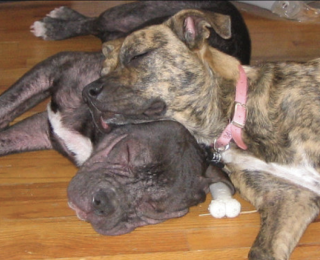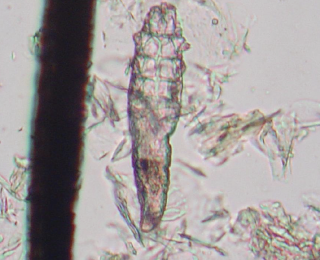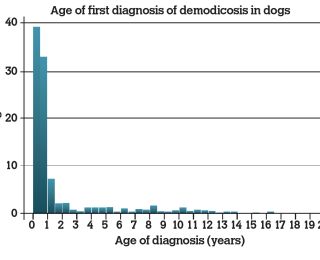Small animal - June 2020
Demodicosis in first opinion caseloads of dogs: the ‘mitey’ facts on frequency and breeds
Dr Dan O’Neill, senior lecturer in companion animal epidemiology at the Royal Veterinary College, outlines a study aimed at exploring the epidemiological features of demodicosis relevant to the general UK dog population
Demodicosis is a common skin disease in dogs, with both juvenile-onset and adult-onset presentations described. Certain breeds are reported with predisposition for genetic or acquired immunosuppression assumed as central to pathogenesis. This study aimed to explore the epidemiological features of demodicosis relevant to the general UK dog population.
The study used anonymised clinical data recorded on dogs attending primary veterinary practices enrolled in the UK VetCompass Programme. Cases were included if they had demodicosis diagnosed during the 2013 study period. Risk factor analysis used multivariable logistic regression modelling.
In dogs aged <2 years (juvenile-onset), the one-year period prevalence was 0.48% (95% CI: 0.45-0.52). Compared with crossbred dogs, seven breeds showed increased odds: British Bulldog, Staffordshire Bull Terrier, Chinese Shar-Pei, Dogue de Bordeaux, Pug, French Bulldog and Boxer. Additionally, six breeds showed reduced odds of juvenile demodicosis: Lhasa Apso, Bichon, Labrador Retriever, German Shepherd Dog, Shih Tzu and Chihuahua.
In dogs aged >4 years (adult-onset), the one-year period prevalence was 0.05% (95% CI: 0.0.04-0.06). Six breeds showed increased odds of demodicosis compared with crossbred dogs: Chinese Shar-Pei, Shih Tzu, West Highland White Terrier, Pug, Boxer and Border Terrier.
Small-animal practitioners should be aware that juvenile-onset demodicosis is much more common (about 10 times higher) than the adult-onset form. Knowledge of the predisposed breeds for these two presentations can assist with improved diagnosis and support the concept of distinct aetiopathogenetic phenotypes.
Background
Demodicosis is a relatively common skin disease in dogs that occurs when the normally harmless and commensal Demodex spp. mites in hair follicles and/or sebaceous glands multiply to excessive numbers (see Figure 1).1
Two species of demodectic mites are associated with disease in dogs: Demodex canis and Demodex injai.2-4 Very low numbers of D. canis inhabit haired skin of dogs without skin disease (see Figure 2).5
Canine demodicosis is commonly classified by either the age at onset (juvenile versus adult) and/or the extent of the disease (localised versus generalised) to assist with prognostic advice and to guide diagnostic and management approaches.6 Demodicosis is not uncommonly associated with secondary bacterial skin infection,7 and deep and extensive pyoderma can lead to serious, debilitating or even life-threatening morbidity in generalised disease.1 Due to the suspected genetic factors involved, breeding from affected dogs is discouraged and greater understanding of breed-associations is needed.8 Distinct risk factors are likely to exist between juvenile-onset and adult-onset demodicosis that may offer routes to better understanding and management of the condition.
Reported prevalence values for canine demodicosis vary widely, from 0.4% to 23%.9-15 Reported breed predispositions also vary widely, with bull dog and bull terrier types and Shar-Pei dogs having high-reported odds of diagnosis with juvenile demodicosis,14 but crossbred dogs were the most frequently represented dogs in the study of overall demodicosis.15 This variation may result from studies using skewed populations, so there is a need for reliable information that relates to the general population of dogs under primary veterinary care. This study aimed to:
- report the one-year period prevalence and age distribution of demodicosis in dogs of all ages attending primary care practices in the UK; and
- report the one-year period prevalence and evaluate risk factors for demodicosis separately for dogs under two years of age (juvenile-onset) and for those aged over four years (presumed adult-onset).
The data
The VetCompass Programme collates de-identified electronic patient records (EPR) from primary care veterinary practices in the UK for epidemiological research.16 The study included dogs with a final diagnosis of demodicosis recorded in the clinical records for a dermatological condition present during 2013.
Breeds with >5,000 dogs and/or with ≥10 demodicosis cases were included individually along with a general grouping of crossbred dogs and a grouped category of all remaining purebred dogs. Age described the age (years) at first diagnosis for newly diagnosed (incident) demodicosis cases during 2013 and at December 31, 2013 for non-cases. A bodyweight relative to breed/sex mean variable characterised the adult bodyweight of individual dogs as either below or equal/above the mean adult bodyweight for their breed and sex.
Analyses were conducted using Stata Version 13 (Stata Corporation). Prevalence describes all cases, whether incident or pre-existing, during the one-year 2013 study period.17 Incidence describes cases that were newly diagnosed during 2013. Risk factor analysis was carried out separately for dogs aged <2 years and for dogs aged >4 years. Binary logistic regression modelling was used to evaluate associations between risk factors (breed, pure-bred, adult bodyweight, bodyweight relative to breed/sex mean, age category, sex, neuter) and diagnosis with demodicosis during 2013.
Results
- Prevalence
Overall: From dogs of all ages, there were 788 demodicosis cases confirmed from 455,553 dogs under veterinary care during 2013 at 304 clinics to give a one-year period prevalence for demodicosis overall of 0.17% (95% CI: 0.16-0.19). The breeds with the highest demodicosis one-year period prevalence across all ages were British Bulldog (1.5%), French Bulldog (1.3%), Pug (1.0%), Dogue de Bordeaux (0.9%) and Chinese Shar-Pei (0.9%). The median age at first diagnosis overall was seven months (interquartile range [IQR] four months to 13 months, range one month to 16 years and 2 months). See Figure 3.
Juvenile-onset: From dogs aged <2 years, there were 613 demodicosis cases confirmed from 126,423 dogs to yield a one-year period prevalence of 0.48% (95% CI: 0.0.45-0.52). Breeds with the highest prevalence of juvenile-onset demodicosis were British Bulldog (3.6%), Staffordshire Bull Terrier (2.1%), Pug (1.9%), French Bulldog (1.9%), Chinese Shar-Pei (1.8%) and Dogue de Bordeaux (1.8%).
Adult-onset: From dogs aged >4 years, there were 117 demodicosis cases confirmed from 228,801 dogs to yield a one-year period prevalence of 0.05% (95% CI: 0.0.04-0.06). Breeds with the highest prevalence of adult-onset demodicosis one-year were Chinese Shar-Pei (0.6%), Shih Tzu (0.4%), West Highland White Terrier 0.2%), Dogue de Bordeaux 0.2%) and Pug (0.2%).
- Risk factors
Juvenile-onset: Seven breeds showed increased odds of juvenile-onset demodicosis compared with crossbred dogs: British Bulldog (odds ratio [OR]: 11.26), Staffordshire Bull Terrier (OR: 7.11), Chinese Shar-Pei (OR: 6.57) Dogue de Bordeaux (OR: 5.92), Pug (OR: 5.41), French Bulldog (OR: 5.07) and Boxer (OR: 2.04). Six breeds had reduced odds of juvenile-onset demodicosis: Lhasa Apso, Bichon, Labrador Retriever, German Shepherd Dog, Shih Tzu and Chihuahua. Additionally, zero cases were identified for Yorkshire Terrier and Golden Retriever. Dogs weighing equal or higher than their breed mean had 1.50 times the odds compared with dogs that weighed below their breed mean. Dogs aged 1.0- <2.0 years had 0.12 times the odds of demodicosis compared with dogs aged <1.0 years. Compared with entire females, there were higher odds in neutered females (OR 1.44) and neutered males (OR 1.32). Purebred dogs had 1.50 times the odds compared with crossbred dogs. Dogs weighing 10.0-19.9kg (OR: 3.55) and 20.0-29.9 kg (OR: 5.42) had the highest odds of juvenile demodicosis compared with dogs weighing <10.0kg.
Adult-onset: Six breeds showed increased odds of adult-onset demodicosis compared with crossbred dogs: Chinese Shar-Pei (OR: 21.91), Shih Tzu (OR: 15.42), West Highland White Terrier (OR: 8.34), Pug (OR: 5.42), Boxer (OR: 3.90) and Border Terrier (OR: 3.72). There were four breeds with zero demodicosis cases identified: French Bulldog, Border Collie, Chihuahua and Bichon. Purebred dogs had 2.16 times the odds compared with crossbred dogs. Dogs weighing 20.0-29.9kg (OR: 0.37) and 30.0-39.9 kg (OR: 0.40) had lower odds of demodicosis compared with dogs weighing <10.0 kg.
Comparing results between juvenile-onset and adult-onset demodicosis, three breeds showed evidence of increased odds in both age groups: Chinese Shar-Pei, Pug and Boxer.
Discussion
This study explored the wider presentation of demodicosis in dogs under primary veterinary care in the UK to provide more generalisable results than previous studies that had mainly relied on smaller datasets from teaching hospital or referral practice populations.9,10,15,18 In this study, a diagnosis of demodicosis was accepted based upon the clinical opinion of the primary-care clinician. Given that full diagnostic testing may not have been carried out in all potential cases, the current study results may underestimate the true disease prevalence. Two age-related presentations of demodicosis are recognised: ‘juvenile-onset’ demodicosis which usually first manifests in puppyhood or young adulthood (three-18 months), and adult-onset demodicosis which usually first manifesting after four years of age.1 The results of the current study with 79.6% of first diagnoses relating to cases under 1.5 years of age support the literature that the majority of demodicosis cases in dogs are juvenile-onset.1
The expression of juvenile-onset disease may be linked to the gradual expansion of mite populations5,19 following mite transmission during the first days of life.20 Dogs that are first diagnosed when four years of age, or older, are likely to have a truly ‘adult-onset’ form of the disease.1 This differentiation matters because juvenile-onset demodicosis is generally attributed to a genetic makeup that confers a mite-specific immune dysfunction that usually occurs in the absence of other identifiable immune-dysregulating factors. In contrast, the adult-onset caseloads carry a high index of suspicion of some acquired immune-compromise through disease or medication, reducing the host’s ability to control mite numbers later in life.1-21 In adult-onset cases, the prognosis depends on the identification and management of relevant co-morbidity as well as managing the demodicosis.6
The current study identified juvenile-onset demodicosis in one in 200 of dogs aged under two years of age (0.48% prevalence), suggesting that demodicosis is a relatively common and, therefore, important disease in this age group of dogs and should be included within differential diagnosis for relevant dermatological presentations in this age group. Many dogs with juvenile-onset demodicosis are not subsequently diseased in adulthood, suggesting that the poorly understood, suspected mite-specific immunocompromise in young dogs may be transient or dependent on co-factors present only at this life stage.6,15,21
Of the seven breeds predisposed to juvenile-onset demodicosis in the current study, five (British Bulldog, Staffordshire Bull Terrier, Dogue de Bordeaux, French Bulldog and Boxer) belonged to the same genetic clade which includes bull terrier breeds.22,23 Juvenile demodicosis has long been suspected to have a hereditary basis.21 Given the common ancestry of these breeds with increased odds of demodicosis at a young age, it is reasonable to suspect a significant, shared genetic basis for this disease phenotype.
Interestingly, five of the six breeds with increased odds for adult-onset demodicosis represent distinct genetic clades.22 Additionally, the bull-type breeds predisposed for the juvenile form of the disease are not represented in the adult-onset breed list. This differing breed spectrum supports the notion that the juvenile and adult-onset forms indeed represent different aetiologies of the disease.8
Three breeds, Shih Tzu, West Highland White Terrier and Border Terrier, had increased odds of only adult-onset demodicosis. A wide range of immunocompromising factors has been proposed as triggers for adult-onset demodicosis,8 many of which typically affect older dogs. Based on current observations and the limited understanding of the pathogenesis of canine demodicosis,21 increased odds for disease in dogs aged >4 years may thus reflect a genetic background that promotes both longevity and immunosuppressive co-factors (ie. diseases that receive immunocompromising treatment or immunocompromising disease themselves) and/or an acquired mite-specific immune dysfunction.
It is difficult to explain why bodyweight above that of the breed/sex mean in dogs under two years of age was associated with increased (x1.5) odds for demodicosis. Heavier bodyweight could reflect either increased body condition (eg. obesity) or just simply larger inherent stature/size. The current study did not have access to accompanying morphometric data (eg. body condition) on individual dogs and, therefore, it was not possible to interpret the causes of differing bodyweights.24 In humans, obesity is linked to pro-inflammatory states and increased risk of various inflammatory diseases, including rosacea,25 an inflammatory skin disease associated with high populations of Demodex mites.19
The association between juvenile-onset demodicosis and neutered status may reflect reverse causality whereby demodicosis cases may have increased probability of neutering after diagnosis.26
The study had some limitations. Primary-care clinical data are not recorded primarily for research purposes and thus were limited by some missing data as well as reliance on accurate and thorough record-keeping of the clinicians. As discussed above, the study relied on diagnoses recorded by primary-care clinician teams. Varying diagnostic criteria across clinics and individual veterinarians may have introduced some selection bias to the final results that is difficult to quantify.
Conclusions
This study of the general dog population under primary veterinary care showed 10 times higher prevalence of demodicosis in dogs aged under two years (0.48%) than in dogs aged over four years (0.05%). It identified breed as a major risk factor for both age groups. Differing spectra of predisposed breeds across the juvenile-onset and adult-onset forms of the disease supports the concept of distinct age-related aetiopathogenetic phenotypes of this complex disease. These findings will help inform case selection for future work investigating primary genetic risk factors, and also relevant co-factors for disease expression. This is particularly relevant information for veterinary surgeons given the marked rise in popularity in recent years of breeds such French Bulldog, Pug, British Bulldog and Staffordshire Bull Terrier as with increased odds of juvenile demodicosis in the UK.
- Miller WH, Griffin CE, Campbell KL. Canine demodicosis. In: Miller WH, Griffin CE, Campbell KL, editors. Muller & Kirk's Small Animal Dermatology. 7th ed. St. Louis, Missouri: Elsevier; 2013. p. 284-342.
- Hillier A, Desch CE. Large-bodied Demodex mite infestation in 4 dogs. Journal of the American Veterinary Medical Association. 2002;220(5):623-7.
- Sastre N, Ravera I, Villanueva S, Altet L, et al. Phylogenetic relationships in three species of canine Demodex mite based on partial sequences of mitochondrial 16S rDNA. Veterinary Dermatology. 2012;23(6):509-e101.
- Mueller RS, Rosenkrantz W, Bensignor E, Karaš-Tecza J, Paterson T, Shipstone M. WAVD Clinical consensus guidelines for demodicosis. 2018.
- Ravera I, Altet L, Francino O, Sánchez A, Roldán W, Villanueva S, et al. Small Demodex populations colonize most parts of the skin of healthy dogs. Veterinary Dermatology. 2013;24(1):168-72.
- Mueller RS, Bensignor E, Ferrer L, Holm B, et al. Treatment of demodicosis in dogs: 2011 clinical practice guidelines. Veterinary Dermatology. 2012;23(2):86-9-e20-1.
- Kuznetsova E, Bettenay S, Nikolaeva L, Majzoub M, Mueller R. Influence of systemic antibiotics on the treatment of dogs with generalized demodicosis. Veterinary Parasitology. 2012;188(1-2):148-55.
- Scott DW, Miller WH, Griffin CE. Parasitic skin disease. In: Scott DW, Miller WH, Griffin CE, Muller GH, editors. Muller & Kirk's Small Animal Dermatology. 6th ed. Philadelphia: Saunders; 2001.
- Sischo WM, Ihrke PJ, Franti CE. Regional distribution of ten common skin diseases in dogs. Journal of the American Veterinary Medical Association. 1989;195(6):752-6.
- Scott DW, Paradis M. A survey of canine and feline skin disorders seen in a university practice: Small Animal Clinic, University of Montreal, Saint-Hyacinthe, Quebec (1987-1988). The Canadian Veterinary Journal [La Revue Veterinaire Canadienne]. 1990;31(12):830-5.
- Nayak DC, Tripathy SB, Dey PC, Ray SK, et al. Prevalence of canine demodicosis in Orissa (India). Veterinary Parasitology. 1997;73(3-4):347-52.
- Rodriguez-Vivas RI, Ortega-Pacheco A, Rosado-Aguilar JA, Bolio GME. Factors affecting the prevalence of mange-mite infestations in stray dogs of Yucatán, Mexico. Veterinary Parasitology. 2003;115(1):61-5.
- Chee J-H, Kwon J-K, Cho H-S, Cho K-O, et al. A survey of ectoparasite infestations in stray dogs of Gwang-ju City, Republic of Korea. Korean Journal of Parasitology. 2008;46(1):23-7.
- Plant JD, Lund EM, Yang M. A case–control study of the risk factors for canine juvenile-onset generalized demodicosis in the USA. Veterinary Dermatology. 2011;22(1):95-9.
- Bowden DG, Outerbridge CA, Kissel MB, Baron JN, White SD. Canine demodicosis: a retrospective study of a veterinary hospital population in California, USA (2000–2016). Veterinary Dermatology. 2018;29(1):19-e0.
- VetCompass. VetCompass™ Programme London: RVC Electronic Media Unit; 2020 [Available from: http://www.rvc.ac.uk/VetCOMPASS/.
- Thrusfield M. Veterinary Epidemiology. 3rd ed. Oxford: Blackwell Publishing; 2007. 610 p.
- LemariÉ SL, Hosgood G, Foil CS. A retrospective study of juvenile- and adult-onset generalized demodicosis in dogs (1986–91). Veterinary Dermatology. 1996;7(1):3-10.
- Forton FMN. Papulopustular rosacea, skin immunity and Demodex: pityriasis folliculorum as a missing link. Journal of the European Academy of Dermatology and Venereology. 2011;26(1):19-28.
- Greve J, Gaafar S. Natural transmission of Demodex canis in dogs. Journal of the American Veterinary Medical Association. 1966;148(9):1043-5.
- Ferrer L, Ravera I, Silbermayr K. Immunology and pathogenesis of canine demodicosis. Veterinary Dermatology. 2014;25(5):427-e65.
- Parker HG, Dreger DL, Rimbault M, Davis BW, et al. Genomic analyses reveal the influence of geographic origin, migration, and hybridization on modern dog breed development. Cell Reports. 2017;19(4):697-708.
- Olson KR, Levy JK, Norby B, Crandall MM, et al. Inconsistent identification of pit bull-type dogs by shelter staff. The Veterinary Journal. 2015;206(2):197-202.
- Anderson KL, O'Neill DG, Brodbelt DC, Church DB, et al. Prevalence, duration and risk factors for appendicular osteoarthritis in a UK dog population under primary veterinary care. Scientific Reports. 2018;8(1):5641.
- Li S, Cho E, Drucker AM, Qureshi AA, Li W-Q. Obesity and risk for incident rosacea in US women. Journal of the American Academy of Dermatology. 2017;77(6):1083-7.e5.
- Jacka FN, Cherbuin N, Anstey KJ, Butterworth P. Does reverse causality explain the relationship between diet and depression? Journal of Affective Disorders. 2015;175:248-50.
1) Which of these mites are common causes of demodicosis in dogs?
A. Demodex catis
B. Demodex canis
C. Demodex injai
D. Demodex pei
E. Demodex demodex
2) Which of the following breeds are predisposed to juvenile-onset demodicosis?
A. Dogue de Bordeaux
B. Chinese Shar-Pei
C. British Bulldog
D. Boxer
E. Pug
3) What proportion of dogs under 2 years have demodicosis?
A. 0.08%
B. 0.28%
C. 0.48%
D. 0.68%
E. 0.88%
4) How many times more common is juvenile-onset demodicosis compared to adult-onset?
A. Equal
B. 2 times
C. 5 times
D. 8 times
E. 10 times
5) Which of the following breeds were protected against juvenile-onset demodicosis?
A. Staffordshire Bull Terrier
B. Labrador Retriever
C. French Bulldog
D. German Shepherd Dog Boxer
E. Bichon
Answers: 1: B&C; 2: All of them; 3: c; 4: E; 5: b,d,e.












